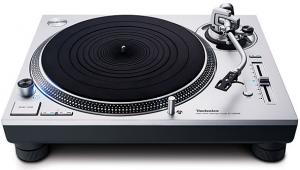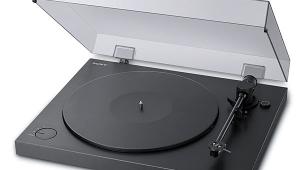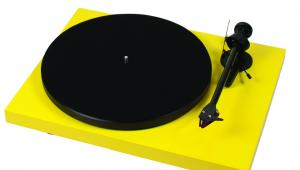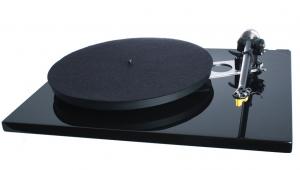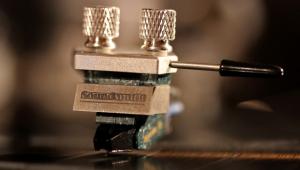Monolith By Monoprice Belt-Drive Turntable Review Page 2
To complete the turntable setup you lower the platter onto the main bearing and stretch the belt into place over the motor pulley. It took a few attempts to get the belt to ride between the pulley's two flanges without sliding up, but once it was correctly seated it stayed firmly in place. The Monolith's electronic speed switching means that, unlike with some turntables in this price class, you won't have to manually move the belt to switch between 33 1/3 and 45 rpm playback. Speaking of speeds, a check with a strobe disc revealed that the Monolith as received was running noticeably fast, with a speed error of around 2%. There is no official user adjustment for speed so I cheated and removed the cover over the motor where I found two adjustment screws in the base of the motor—one for 33 1/3 and one for 45. With these, I was able to correct the speed but it's not clear if making this unofficial tweak will void the warranty. The good news is that the turntable is powered by a 12-volt DC power supply, so you're unlikely to get zapped in the process.
The Monolith is supported by three footers which is great for stability, but they aren't adjustable, so you'll need to make sure your shelf is level, or stick a beer coaster or two under the feet if things aren't perfectly plumb. The final step is to slide the nice quality dust cover onto the hinges attached to the rear of the plinth.
For most of my listening I connected the analog RCA outputs to my Denon AVR-X8500H A/V receiver, switching between the phono preamp in the turntable and the one built into the receiver. Curiously, Monoprice includes a USB cable for the computer hookup but no RCA cables for making this far more common connection. While most of us will have a suitable cable stuck away in a drawer somewhere, keep in mind that you'll also need to come up with a ground wire if you plan to use an outboard phono preamp. Hey Monoprice, you're the low-cost cable people. How hard would it be to include a set of RCA cables that 95% of users are going to need?
Listening
I kicked off my listening with the song "Laura" from The Poll Winners album Straight Ahead (Contemporary S-7635). I normally expect budget turntables to sound a bit thin and wimpy with music like this, but on the Monolith the sound was surprisingly full-bodied, with a nice rich tone from Ray Brown's acoustic bass and a clean yet vibrant tone from Barney Kessel's electric guitar. The general sonic balance leaned a bit toward the warm and soft side of neutral, lacking some of the crystalline clarity of turntables that aim a bit higher, but the overall impression was engaging and enjoyable.
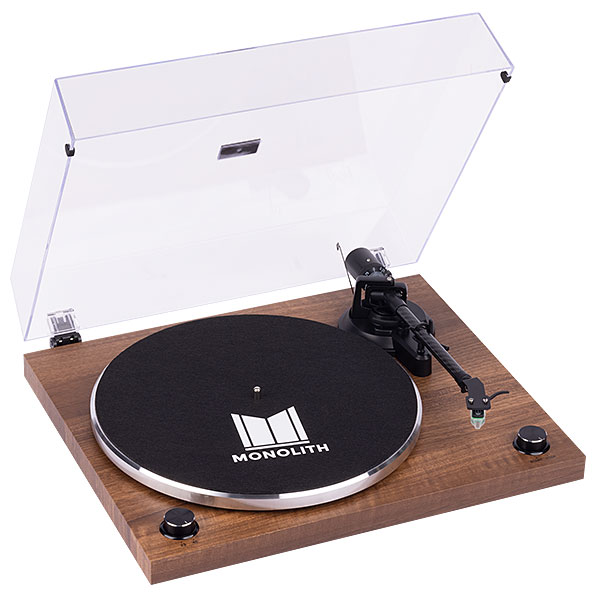
To explore this impression further, I played Depeche Mode's Violator album (Mute Stumm 64), a much denser sounding recording. The Monolith did a pretty credible job of unraveling this thicker production, spreading out the layers of sound in an easy to follow way. The synth bass was able to dig pretty deep while remaining tuneful and tight, adding to an overall sound I would describe as slightly soft and warm.
Pitch stability can be a difficult area for budget turntables, so I put on a recording of Willhelm Kempff playing Beethoven's "Moonlight" piano sonata (Deutsche Grammophon 136 227). Here the shortcomings of the Monolith's low-mass platter and humble drive system became more evident, not so much as a clearly identifiable loss of pitch stability, but more as a loss of the solidity and power you hear behind each note with more ambitious turntable designs. This is a very dynamic recording, and while the turntable may not have been able to muster all of that power and stability, the Monolith/AT-VM95E combo never had any trouble following Mr. Kempff's hammering on the keyboard and did so without so much as a whiff of the dreaded mistracking or inner groove distortion.
In the final analysis, the Monolith's built-in phono preamp performed reasonably well, though it was outshined by the Denon's onboard phono preamp in terms of image scale, focus, and dynamic punch, which is not surprising considering the AVR-X8500H is a $4,000 flagship receiver. In the context of keeping cost down, it probably doesn't make a lot of sense to worry about switching to an outboard phono preamp, but if the one in a receiver you plan to use sounds better, great.
Conclusion
No $250 turntable is going to be perfect, but it's generally preferable if a product's limitations are in its ability to give you the whole picture, rather than by adding some distortions or color of its own. The Monolith turntable stays on the right side of this equation, always sounding enjoyable and engaging and never harsh or rough. It brings you a somewhat downsized but clear window on why people like records, and is a perfect gateway into the world of vinyl. If Monoprice can sort out the issues I experienced with the factory speed setting and arm height, it would become an even greater value.


